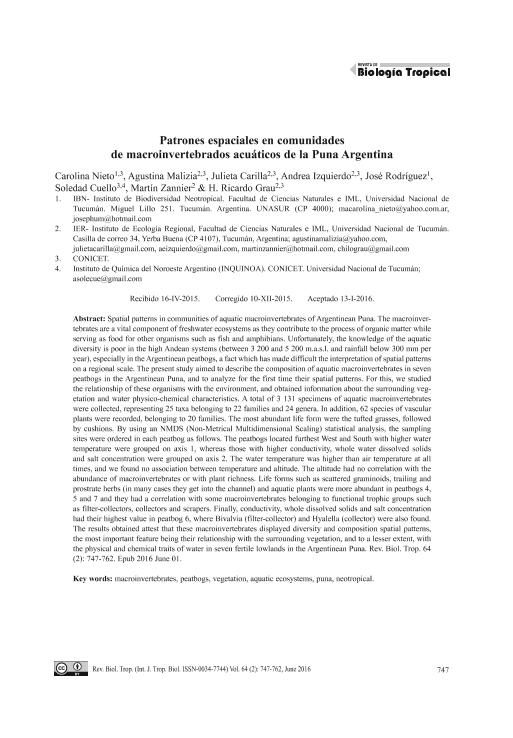Mostrar el registro sencillo del ítem
dc.contributor.author
Nieto Peñalver, María Carolina

dc.contributor.author
Malizia, Agustina

dc.contributor.author
Carilla, Julieta

dc.contributor.author
Izquierdo, Andrea Elisa

dc.contributor.author
Rodríguez, José Sebastián

dc.contributor.author
Cuello, Ana Soledad

dc.contributor.author
Zannier, Martin

dc.contributor.author
Grau, Hector Ricardo

dc.date.available
2018-09-28T19:31:18Z
dc.date.issued
2016-06
dc.identifier.citation
Nieto Peñalver, María Carolina; Malizia, Agustina; Carilla, Julieta; Izquierdo, Andrea Elisa; Rodríguez, José Sebastián; et al.; Patrones espaciales en comunidades de macroinvertebrados acuáticos de la Puna Argentina; Revista de Biología Tropical; Revista de Biología Tropical; 64; 2; 6-2016; 747-762
dc.identifier.issn
0034-7744
dc.identifier.uri
http://hdl.handle.net/11336/61294
dc.description.abstract
The macroinvertebrates are a vital component of freshwater ecosystems as they contribute to the process of organic matter while serving as food for other organisms such as fish and amphibians. Unfortunately, the knowledge of the aquatic diversity is poor in the high Andean systems (between 3 200 and 5 200 m.a.s.l. and rainfall below 300 mm per year), especially in the Argentinean peatbogs, a fact which has made difficult the interpretation of spatial patterns on a regional scale. The present study aimed to describe the composition of aquatic macroinvertebrates in seven peatbogs in the Argentinean Puna, and to analyze for the first time their spatial patterns. For this, we studied the relationship of these organisms with the environment, and obtained information about the surrounding vegetation and water physico-chemical characteristics. A total of 3 131 specimens of aquatic macroinvertebrates were collected, representing 25 taxa belonging to 22 families and 24 genera. In addition, 62 species of vascular plants were recorded, belonging to 20 families. The most abundant life form were the tufted grasses, followed by cushions. By using an NMDS (Non-Metrical Multidimensional Scaling) statistical analysis, the sampling sites were ordered in each peatbog as follows. The peatbogs located furthest West and South with higher water temperature were grouped on axis 1, whereas those with higher conductivity, whole water dissolved solids and salt concentration were grouped on axis 2. The water temperature was higher than air temperature at all times, and we found no association between temperature and altitude. The altitude had no correlation with the abundance of macroinvertebrates or with plant richness. Life forms such as scattered graminoids, trailing and prostrate herbs (in many cases they get into the channel) and aquatic plants were more abundant in peatbogs 4, 5 and 7 and they had a correlation with some macroinvertebrates belonging to functional trophic groups such as filter-collectors, collectors and scrapers. Finally, conductivity, whole dissolved solids and salt concentration had their highest value in peatbog 6, where Bivalvia (filter-collector) and Hyalella (collector) were also found. The results obtained attest that these macroinvertebrates displayed diversity and composition spatial patterns, the most important feature being their relationship with the surrounding vegetation, and to a lesser extent, with the physical and chemical traits of water in seven fertile lowlands in the Argentinean Puna.
dc.format
application/pdf
dc.language.iso
spa
dc.publisher
Revista de Biología Tropical

dc.rights
info:eu-repo/semantics/openAccess
dc.rights.uri
https://creativecommons.org/licenses/by-nc-sa/2.5/ar/
dc.subject
Aquatic Ecosystems
dc.subject
Macroinvertebrates
dc.subject
Neotropical
dc.subject
Peatbogs
dc.subject
Puna
dc.subject
Vegetation
dc.subject.classification
Otras Ciencias Biológicas

dc.subject.classification
Ciencias Biológicas

dc.subject.classification
CIENCIAS NATURALES Y EXACTAS

dc.title
Patrones espaciales en comunidades de macroinvertebrados acuáticos de la Puna Argentina
dc.title
Spatial patterns in communities of aquatic macroinvertebrates of Argentinean Puna
dc.type
info:eu-repo/semantics/article
dc.type
info:ar-repo/semantics/artículo
dc.type
info:eu-repo/semantics/publishedVersion
dc.date.updated
2018-08-28T13:34:43Z
dc.journal.volume
64
dc.journal.number
2
dc.journal.pagination
747-762
dc.journal.pais
Costa Rica

dc.journal.ciudad
Turrialba
dc.description.fil
Fil: Nieto Peñalver, María Carolina. Consejo Nacional de Investigaciones Científicas y Técnicas. Centro Científico Tecnológico Conicet - Tucuman. Instituto de Biodiversidad Neotropical. Universidad Nacional de Tucuman. Facultad de Ciencias Naturales e Instituto Miguel Lillo. Instituto de Biodiversidad Neotropical. Instituto de Biodiversidad Neotropical; Argentina
dc.description.fil
Fil: Malizia, Agustina. Universidad Nacional de Tucumán. Instituto de Ecología Regional. Consejo Nacional de Investigaciones Científicas y Técnicas. Centro Científico Tecnológico Conicet - Tucumán. Instituto de Ecología Regional; Argentina
dc.description.fil
Fil: Carilla, Julieta. Universidad Nacional de Tucumán. Instituto de Ecología Regional. Consejo Nacional de Investigaciones Científicas y Técnicas. Centro Científico Tecnológico Conicet - Tucumán. Instituto de Ecología Regional; Argentina
dc.description.fil
Fil: Izquierdo, Andrea Elisa. Universidad Nacional de Tucumán. Instituto de Ecología Regional. Consejo Nacional de Investigaciones Científicas y Técnicas. Centro Científico Tecnológico Conicet - Tucumán. Instituto de Ecología Regional; Argentina
dc.description.fil
Fil: Rodríguez, José Sebastián. Consejo Nacional de Investigaciones Científicas y Técnicas. Centro Científico Tecnológico Conicet - Tucuman. Instituto de Biodiversidad Neotropical. Universidad Nacional de Tucuman. Facultad de Ciencias Naturales e Instituto Miguel Lillo. Instituto de Biodiversidad Neotropical. Instituto de Biodiversidad Neotropical; Argentina
dc.description.fil
Fil: Cuello, Ana Soledad. Consejo Nacional de Investigaciones Científicas y Técnicas. Centro Científico Tecnológico Conicet - Tucumán. Instituto de Química del Noroeste. Universidad Nacional de Tucumán. Facultad de Bioquímica, Química y Farmacia. Instituto de Química del Noroeste; Argentina
dc.description.fil
Fil: Zannier, Martin. Universidad Nacional de Tucumán. Instituto de Ecología Regional. Consejo Nacional de Investigaciones Científicas y Técnicas. Centro Científico Tecnológico Conicet - Tucumán. Instituto de Ecología Regional; Argentina
dc.description.fil
Fil: Grau, Hector Ricardo. Universidad Nacional de Tucumán. Instituto de Ecología Regional. Consejo Nacional de Investigaciones Científicas y Técnicas. Centro Científico Tecnológico Conicet - Tucumán. Instituto de Ecología Regional; Argentina
dc.journal.title
Revista de Biología Tropical

dc.relation.alternativeid
info:eu-repo/semantics/altIdentifier/doi/https://doi.org/10.15517/rbt.v64i2.18801
dc.relation.alternativeid
info:eu-repo/semantics/altIdentifier/url/https://revistas.ucr.ac.cr/index.php/rbt/article/view/18801
Archivos asociados
